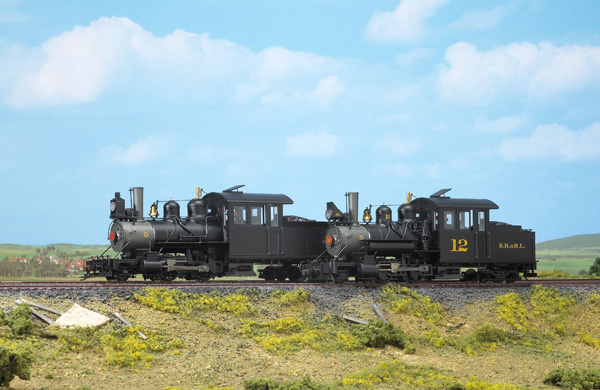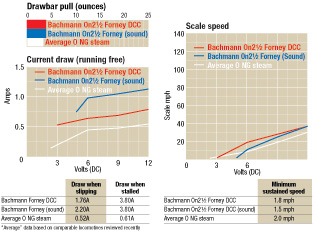The models follow the dimensions of drawings of SR&RL nos. 8 and 9 by H.T. Crittenden. The models reflect the engines in the 1930s near the end of the railroad’s existence, including such specific details as no. 9’s notched tender flare on the painted and lettered SR&RL version.
Both samples included an alternate inside-bearing pony truck, which was a feature on some of the prototype engines. All the wheels on both our samples matched an HO scale National Model Railroad Association gauge. (In O scale, 21/2 feet roughly equals HO gauge track.) Also included with each model were a simple wire mesh cinder catcher for the top of the stack, two alternate headlights, and a packet with a small amount of very fine coal, which could be added to the molded coal pile. The coal pile itself is removable after first taking off the tank, which is held in place by four screws.
The cab interior is well detailed, including painted valves and gauges. Doors and windows open and close. There are no figures in the cab; nor is it lighted.
Piping is all separately applied. The quality of cast parts, such as, the whistle, pop-off valves, bell, and air compressor is excellent.
Lettering is crisp and paint is smoothly applied throughout. The smokebox is painted a fairly dark graphite color, which is consistent with photos of the prototypes, and includes a legible builder’s plate.
The mechanism consists of a can motor with flywheel that drives a worm-and-idler gearbox to power the rear axle. This leaves the area under the boiler unobstructed for a more-realistic appearance.
A cover plate over the axles facilitates lubrication of the gears. For any On2 modelers out there who wondered if they could convert these engines, the answer is not without significantly modifying the frame. The cab and boiler aren’t designed for easy removal.
On DCC, the locomotive’s minimum speed was the same but without the variation. I assume the load compensation feature of the decoder smoothed this out. It may well be that a little running time would result in more-consistent performance on straight DC.
Top speed was 37 mph on DC. Although there are some accounts of Forneys reaching much higher speeds, the model’s speed is right in line with the steam rule of thumb of approximately 1 mph per inch of driver diameter.
The sound-equipped locomotives feature a SoundTraxx Tsu-nami decoder, and the sound is great. The factory settings for the sound levels are too loud for my taste but easy to adjust. Even so, the automatic brake squeal as you slow to a stop is not overdone. A neat feature is separate controls (F2 and F3) for long and short whistles. You can make a short blast with the long whistle, but F3 produces a sharp short blast for each push, making signaling a straightforward task. A CD-ROM instruction manual covers all aspects of decoder use and programming. A simple quick-start printed pamphlet is also included.
As has wonderfully become the norm, this new engine performs well, sounds great, and is accurately detailed. My only wish would be that the variations with and without air compressor and inside and outside frame were not so oddly intertwined with whether or not the model is lettered.
Price: $275 (DCC-equipped, no sound); $400 (DCC-equipped, with sound)
Manufacturer
Bachmann Industries Inc.
1400 E. Erie St.
Philadelphia, PA 19124
www.bachmanntrains.com
Description: Die-cast metal and plastic steam locomotive
Road names: Sandy River & Rangely Lake outside frame – air compressor, SR&RL inside frame – no compressor, unlettered outside frame – no compressor, unlettered inside frame – air compressor
Die-cast metal construction
Drawbar pull: 4 ounces (equivalent to 12 free-rolling O scale freight cars on straight and level track)
Dual-mode DCC decoder
Eight-wheel electrical pickup
Five-pole skew-wound motor
Magnetic knuckle couplers (mounted at correct height)
SoundTraxx Tsunami sound decoder (sound versions only)
Weight: 141/2 ounces (no sound); 15 ounces (with sound)
















It would be good to include recommended minimum track radius in these reviews. Otherwise, great job!
I might start in with On30. Maybe.
An unusual and interesting model, I'm tempted.
Bachmann always makes great trains that I look forward to purchasing. The Bachmann Forney is the best looking On30 model I have seen. Great price too. Even though I will be modelling G scale, the Bachmann Forney may be one of my future locomotives to purchase.
I'm nscale it very nice for those who go for it.
very nice.. my nitpick is to call it On30, not On21/2.. too "lumpy"? Been a happy reader of Model Railroader since 1963.. I was 12 years old!! Still have old American Flyer Atlantic..
peace 'n stuff
Brad Squires
nobs5200@yahoo.com
A good looking locomotive and I'm looking forward to buying one. Good work Bachmann and MR the review.
I'm nscale it very nice for those who go for it.